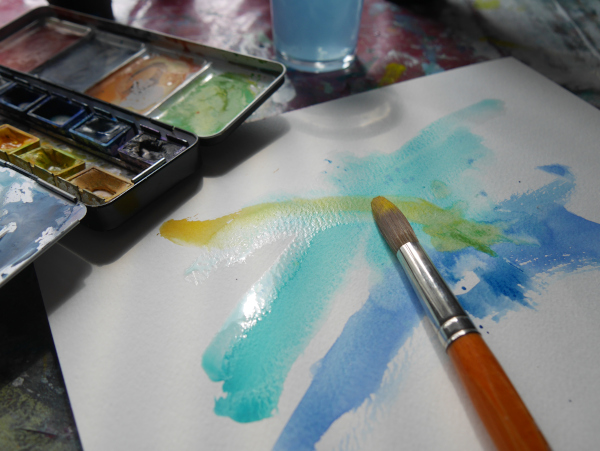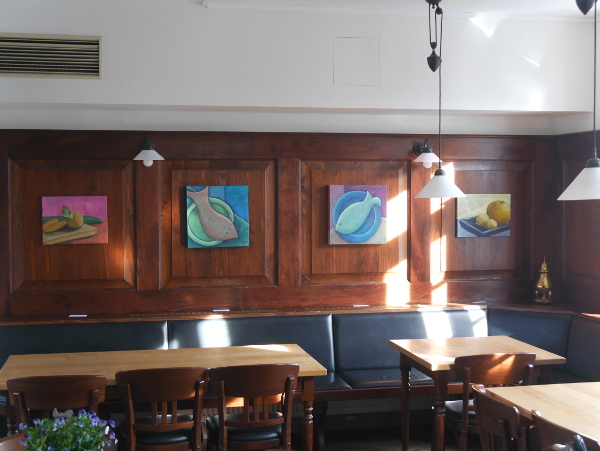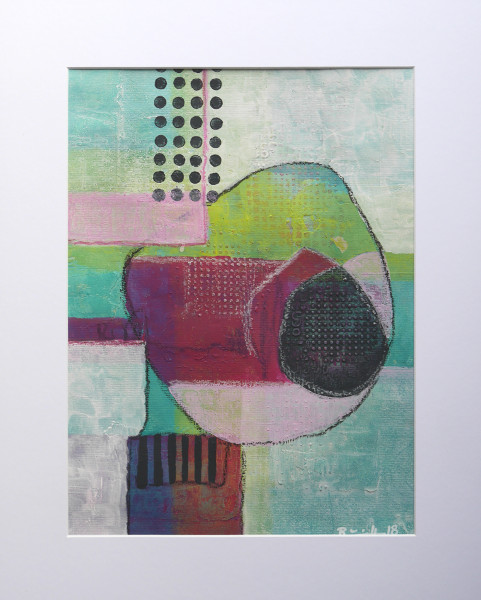„Wieso wünscht du dir Aquarellfarben? Du hast doch nie gerne mit sowas gemalt.“
Meine Eltern schauten mich erstaunt an. Auf ihre Frage nach einem Geburtstagsgeschenk hatte ich kurz überlegt und geantwortet: „Ein Aquarellkasten.“ Damals war ich Dreißig.
Es stimmt, zu Schulzeiten habe ich die Deckfarben gehasst. Praktisch jedes Bild, das ich mit ihnen malen sollte, habe ich versaut. Die Skizze mit Bleistift war okay, doch sobald die Wasserfarben ins Spiel kamen, sobald sich das dünne Papier des Zeichenblocks unter der Feuchtigkeit wellte, war es vorbei.
Ich habe vage Erinnerungen an den Kunstunterricht auf dem Gymnasium. Ein Selbstportrait nur in Schwarz-Weiß-Grau, als würde man sich im Badezimmerspiegel betrachten. Ein Zirkusprojekt, eine Manege mit Attraktionen und Zuschauern, die sich aus vier Einzelbildern von vier Schüler*innen zusammensetzt. Irgendwas mit Eisschollen, die durch Variation in Größe und Farbe Entfernung darstellen. Ein Comic-Bild mit Sprechblase, per Rasterverfahren auf DIN-A2 aufgebläht. Ein riesiger Geldschein, dessen filigrane Muster mit Feder und Tusche über das ganze vorkolorierte Blatt gezeichnet werden mussten.
Ich erinnere mich an solche einzelnen Aufgaben, aber nicht daran, ob wir wirklich beigebracht bekommen haben, mit den Materialien umzugehen. Vermutlich nicht.
Nach dem zehnten Schuljahr hatte ich keinen Kunstunterricht mehr. Da wäre er vermutlich interessant geworden, aber ich hatte die Nase voll. Schade eigentlich.
Zurück zum Aquarellkasten.
Es gab einen ganz einfachen Grund, warum ich ihn haben wollte: Trotzdem!
Mit genügend Abstand zu Schule und Kunstunterricht setzte sich ein Gedanke durch: Du hast immer gerne gezeichnet und gemalt. Wenn es damals nicht funktionierte, lag es nicht unbedingt an dir sondern am Material. Also los, versuch es!
Und genau das habe ich getan. Ich habe mit den Aquarellfarben gespielt, habe ein bisschen darüber gelesen, habe ausprobiert und dann mein Ding gemacht, sprich: meine Bilder gemalt.
Es war mir egal, wie „man eigentlich“ mit ihnen arbeitet. „Man“ und „eigentlich“ fordern bei mir gerne Widerspruch heraus. Natürlich galt auch für mich „Von Hell nach Dunkel.“ und „Das Weiß des Papieres ist das Weiß im Bild.“ Alles andere war meine Sache.
Und so, wie ich mich mit den Aquarellfarben beschäftigt habe, habe ich später auch die Acrylmalerei entdeckt. Anfangen – ohne Scheu ausprobieren – lesen (oder Videos gucken) – wieder ausprobieren. Schritt für Schritt.
Ich denke, das ist etwas, das wir von Kindern lernen können. Neugierig und ohne Angst an eine Sache herangehen, sich nicht entmutigen lassen und den eigenen Weg finden.
Vielleicht hatte Pablo Picasso das im Sinn, als er sagte:
„Jedes Kind ist ein Künstler. Das Problem ist, ein Künstler zu bleiben, wenn du erwachsen bist.“
Why do you want watercolors of all things?
“Why do you want watercolors? You never liked to paint with something like that.”
My parents looked at me in amazement. When they asked for a birthday present, I thought about it for a moment and replied, “A watercolor box.” I was thirty at the time.
It’s true, when I was at school I hated the simpel watercolors. I messed up nearly every picture I was supposed to paint with them. The pencil sketch was okay, but as soon as the watercolors came into play, as soon as the thin paper of the drawing pad curled under the moisture, it was over.
I have vague memories of high school art class. A self-portrait only in black-white-gray, like looking at yourself in the bathroom mirror. A circus project, an arena with attractions and spectators, which is composed of four individual images of four students. Something about ice floes that represent distance through variation in size and color. A comic image with a speech bubble, expanded to A2 using a raster process. A huge banknote, the filigree pattern of which had to be drawn with pen and ink over the entire pre-colored sheet.
I remember such individual tasks, but not whether we were really taught how to use the materials. Probably not.
After the tenth grade, I had no more art classes. They would probably have been interesting then, but I was fed up. It’s a shame, actually.
Back to the watercolor box.
There was a very simple reason why I wanted it: Nevertheless!
With enough distance from school and art class, one thought prevailed: You always enjoyed drawing and painting. If it didn’t work back then, it wasn’t necessarily because of you, but because of the material. So come on, try it!
And that’s exactly what I did. I played with the watercolors, read about them a bit, tried them out and then did my thing, in other words: painted my pictures.
I didn’t care how “you actually” work with them. “You” and “actually” like to challenge me to contradict one another. Of course, “From light to dark” and “The white of the paper is the white in the picture” also applied to me. Everything else was my business.
And just as I dealt with watercolors, I later discovered acrylic painting. Start – try it without hesitation – read (or watch videos) – try again. Step by step.
I think that’s something we can learn from children. Approach something curiously and without fear, do not be discouraged and find your own way.
Perhaps this is what Pablo Picasso had in mind when he said:
“Every child is an artist. The problem is staying an artist when you grow up.”



